Swimming with whale sharks is becoming an increasingly popular tourist activity around the world. As more and more travelers seek out this experience, the rise in tour agencies offering whale shark tours also increases to meet the demand. Unfortunately, with the sudden rise in popularity, this often mean sustainable and ethical practices are bypassed in order to make a quick tourist dollar.
Whale shark tours that involve feeding, touching or disturbing the natural environment of these majestic animals means that whale shark populations around the world are suffering at the hands of tourists wanting to interact with them.
Fortunately, for those looking at ethical whale shark experiences, you’re in luck! All around the world there are many great companies working to support sustainable whale shark excursions and interactions. We’ve put out a call to some of our favorite responsible travel blogger friends to fill us in about their first hand experiences around the world. All of these tours are strictly no touching, feeding or interacting with the whale sharks. So if you’re looking for an experience, look no further!
What is a Whale Shark
Before you consider swimming with whale sharks it might be good to know what one is. A whale shark, despite its name, it not actually a whale, it’s a shark! If you’ve seen a picture of whales sharks it might be hard to imagine you could swim with this scary looking shark. But don’t let the ‘shark’ name put you off, whale sharks pose no threat to humans and feed almost strictly on plankton. They are docile, shy animals that are safe to swim with.
Whale sharks range in size, with the average adult size being almost ten meters long and weighing around nine tonne! Their mouth, one of the most impressive features, can span almost 1.5m wide (5ft), containing up to 350 rows of teeth that work to filter plankton from the water.
Whale sharks are found closer to the equator, as they prefer warmer, tropical waters. With a lifespan of 70-100 years, these majestic creatures truly are some of the most amazing animals you could encounter in the water. Their protection, and the future survival of their species, relies heavily on how we decide to interact with them.

Whale Sharks in the Philippines
Swimming with whale sharks in the Philippines is an activity on the rise! As more and more tourists add the Philippines to their list of ‘must see countries’, whale shark tourism has quickly become a top activity on any Philippines travel itinerary.
As more people look to swim with whale sharks in the Philippines, the pressure is on local tour providers to ensure strict regulations are enforced. While there are many locations that offer this experience, Donsol is the best place to swim with whale sharks in the Philippines without compromising their natural habitat. Oslob, Cebu is also a spot that is popular amongst tourists, but we would encourage you to read on to hear about both experiences before organizing your Philippines trip.
Donsol Whale Shark
First hand experience submitted by Cherene of Wandering Redhead
Donsol Bay is a small village on the island of Luzon where whale shark ecotourism thrives. Fishermen who previously hunted whale sharks are now employed as spotters for tourists. Unlike other whale shark interactions, the whale sharks at Donsol are not fed. They naturally migrate here from the months of December to May. To protect the whale sharks only 30 boats are permitted on the bay at one time, with a maximum of 6 people per boat, not including the boat crew. The boat trips go out three times per day at 8:00am, 11:00am and 2:00pm.
During the interaction, the spotter sits on top of the boat looking for whale sharks. As soon as they see one, the guide encourages guests to position themselves on the boat’s edge while getting snorkels and fins ready. Once the boat is in the ideal position, slightly up current from the shark, the guide yells for everyone to jump in. The current naturally takes swimmers into the shark’s path where they swim along with it for as long as possible. The other boats wait until one boat’s group is done before they try to obtain a good position. This routine is repeated during the 3-hour tour as many times as a whale shark is spotted.
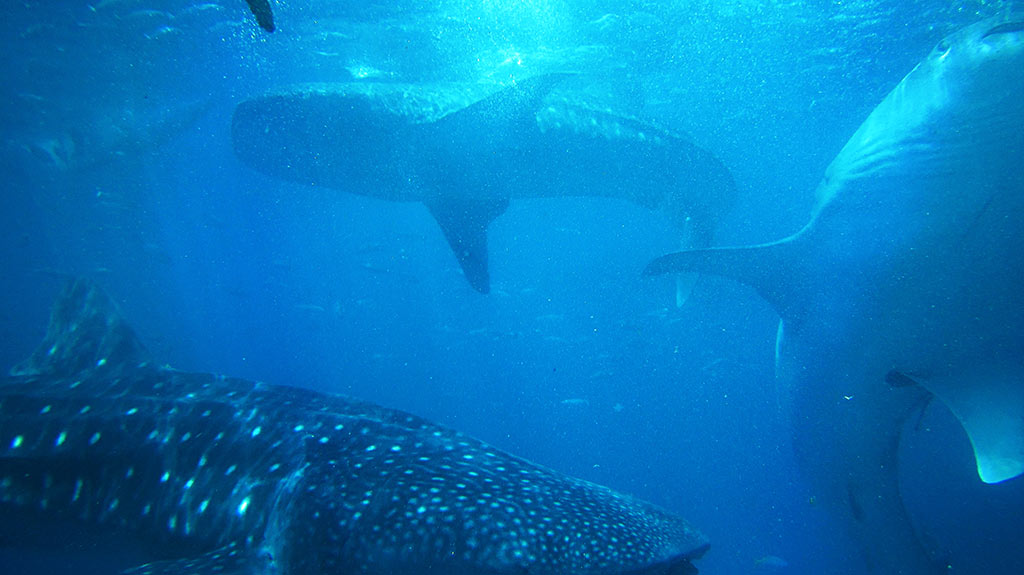
I booked with Donsol Ecotours. They provided airport transfers and a choice of other activities in the region. During the Donsol whale shark tour I didn’t witness anyone disturbing the whale sharks, but I still think there should be fewer people around the shark at one time. Unless you are a strong swimmer, you have to compete with others to see the whale shark clearly beneath the bubbles and splashing caused by frantically kicking fins. Those who could stay with the shark longer had it all to themselves.
As well as the sustainable efforts being made at Donsol, the recent boom of whale shark tourism to Donsol Bay has given the community a welcome income and they now value the whale shark’s welfare more than ever.
Oslob Whale Shark
First hand experience and research by Don’t Forget To Move
If you’ve been following our blog, or if you came across the article separately, you’ll know that we wrote extensively about how unethical the Oslob whale shark experience was. After initially considering the activity while in the Philippines, we decided to do more research before booking. Unfortunately, after researching numerous articles, as well as speaking with marine biology experts in the Philippines, we discovered that this activity was not in the best interest of the whale sharks in Cebu. If you are considering this activity we encourage you to first read our article before booking. Click to read our Oslob whale shark experience article.
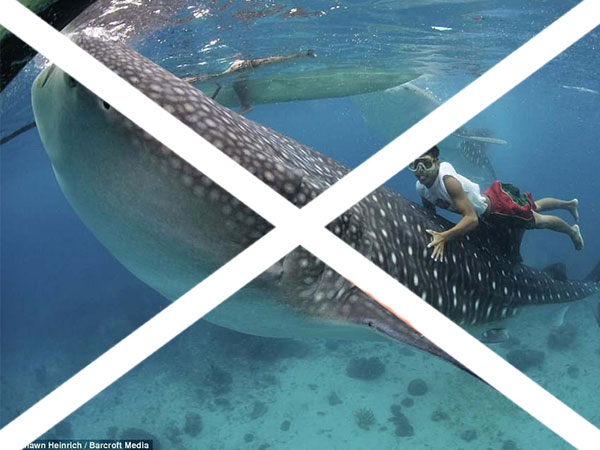
Whale Sharks Mexico
Just a few of hours flight from the United States, there are some great ethical opportunities to swim with whale sharks in Mexico. Ecotourism in Mexico has been on the rise, with more and more companies prioritizing animal welfare over profit. With the continued support of sustainable travelers looking for ethical whale shark encounters, as well as other animal interactions, this will continue to help push the trend into the future. Here are some top locations for swimming with whale sharks in Mexico.
Whale Sharks Cancun
First hand experience submitted by Ernest Shahbazian from Trip Astute
We participated in a whale shark tour in Cancun, Mexico, which was an incredible responsible tourism experience. Our day trip was run by EcoColors Tour, which has been operating whale shark tours in Mexico for over 18 years. They were one of the first tour operators to offer this excursion, and were well organized and staffed.
While we were being transported to the harbor, the tour guides took the time to educate the group on the whale shark and explained what makes them so special. We were nervous as we loaded into the boats and headed toward open water, but we never questioned the integrity of the organization or our tour guide. They expressed great respect for the animals and made it clear that rules and limits were in place to ensure that future generations would have the opportunity to experience this adventure.
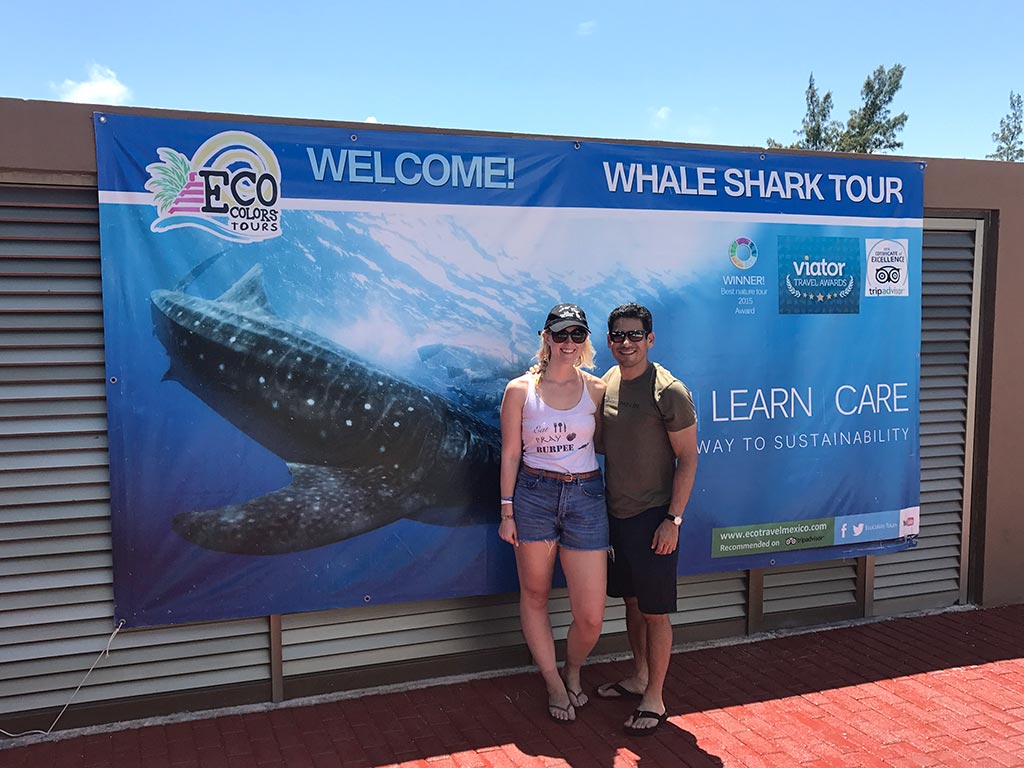
We were particularly impressed that the tour operators strictly adhered to conservation rules and standards, even when pressured by tourists in the group. The tour operators insisted that sunscreen was not allowed on the boat due to its contamination of the water and particularly plankton, the main food source for the whale sharks. They only allowed two people, plus one guide, in the water at a time. We were also told to keep our distance from the whale sharks and that touching and feeding the animals was prohibited.
The tour also managed our expectations well. They told us that there was a possibility that no whale sharks would be found since the sharks are not baited. If that occurred they said we would have the opportunity to snorkel at a nearby reef, though luckily, that was not the case on our tour.
Isla Mujeres Whale Shark
First hand encounter from Alexandra at Travel Fashion Girl
As a scuba diver and marine life lover, responsible ocean tourism is very important to me. I’d heard about the potentially unethical practices in the Philippines and refused to participate in these tours. However, I did have the opportunity to snorkel with whale sharks in Mexico and I was pleasantly surprised by the experience.
The whale shark season in southern Mexico is between the months of June-August. During this time whale sharks migrate off the coast of Cancun near an island called Isla Mujeres. It’s an incredible experience and the whale sharks naturally come together along with manta rays. During this time of year there are hundreds in the area.
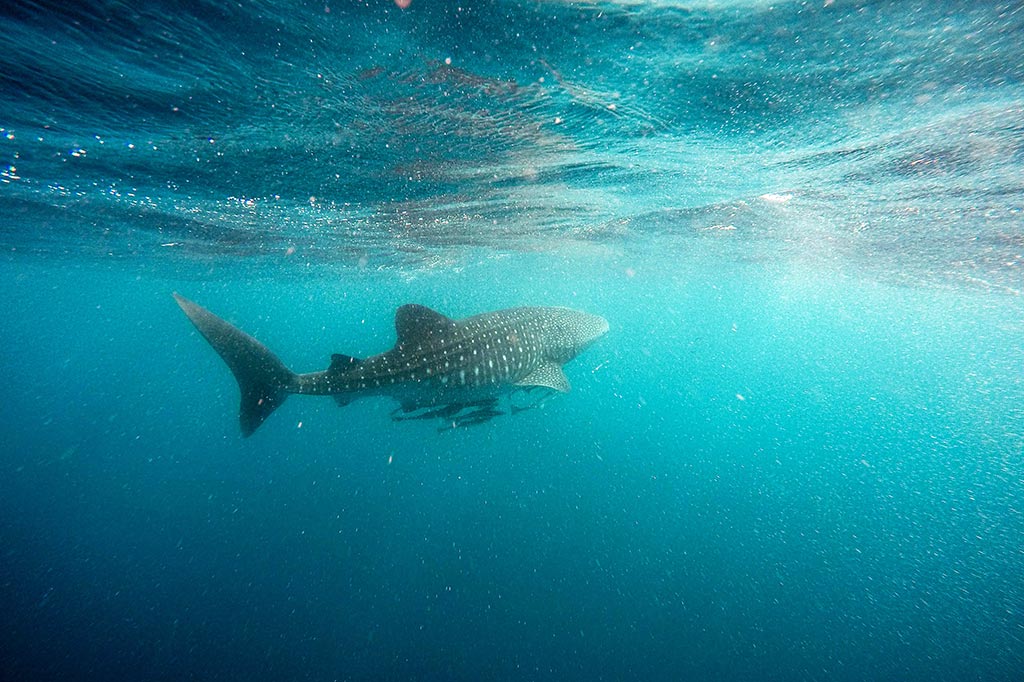
I found the Isla Mujeres whale shark experience to be very responsible, with the animals being viewed in their natural state, not fed and not harmed. While there were a large number of boats that brought tourists to see the whale sharks, but the area is vast and there were at least three whale sharks per boat, so the area is not overcrowded.
I didn’t use a specific company, but I researched the most ethical options on TripAdvisor and found a local guy named Captain Tony. Not only was he the most cost effective option, but he also had great reviews about being respectful of the whale sharks, which was incredibly important to me. He was passionate about the Mexico whale sharks and shared local insight on the migration. He was also very entertaining! During the tour there is no scuba diving allowed, but you can enjoy some whale shark snorkeling.
First hand experience submitted by Elaine J Masters of Trip Well Gal
Once the call came in we sprang into action. A seaplane had spotted the whale sharks and gave our captain coordinates. We scooted away from dock quickly and within twenty minutes the small boat slowed. My first glimpse of a whale shark was that huge mouth swallowing gallons of water slowly, as it hung vertically in the water. Our boat stopped close and carefully and four of us slipped in at a time, paddling quickly closer and closer. Whale sharks feed in plankton rich water, which usually means a murky encounter. It was so cloudy that once I had to back-paddle quickly to avoid the large wide mouth approaching. What an amazing experience to be so close to that gentle and immense beauty.

Since that first encounter, I’ve returned and the next tour was smoother. Our group was small, including a family with an older couple who were happy to watch from the bow. They were prepared as the website cautioned those who couldn’t swim swiftly to stay on board and with a sustainable awareness, it also suggested wearing a bio-degradable, reef safe sunblock. The captain and guide were professional and respectful. They only let a handful of snorkelers get in at a time.
Whale Sharks Exmouth, Western Australia
For those looking to swim with whale sharks in Australia you can’t look past Ningaloo Reef in Western Australia. Located just outside of Exmouth, Ningaloo Reef offers an amazing opportunity to ethically interact with whale sharks. All companies have a high quality of respect for sustainable tourism at Ningaloo Reef, so you can feel confident that you’ll find an ethical company when doing your research.
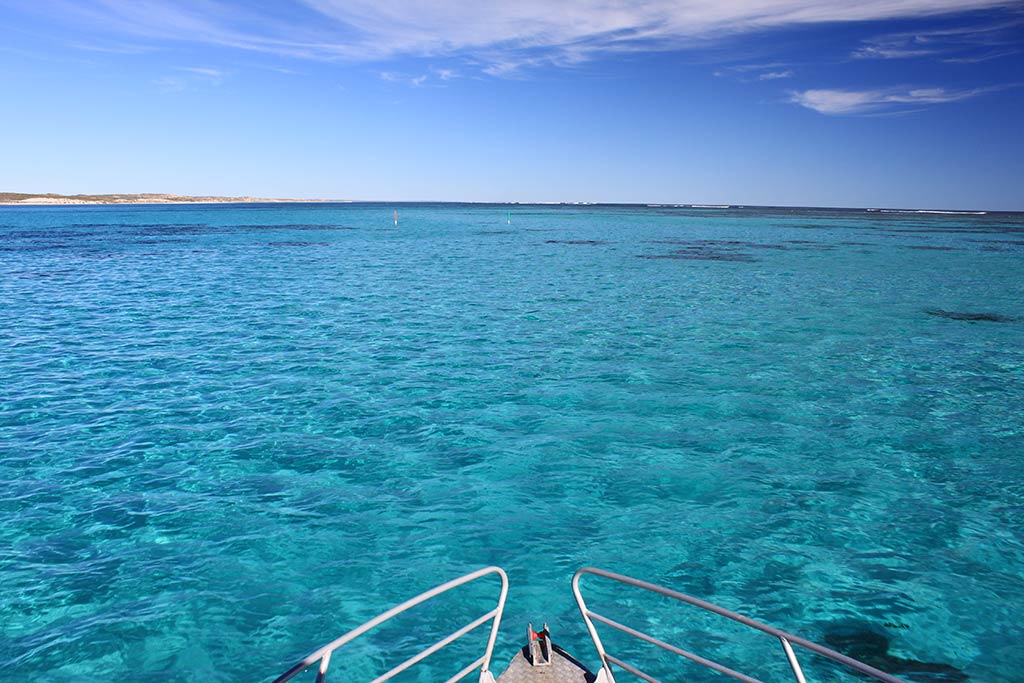
First hand experience by Brittany at The Sweet Wanderlust
The Ningaloo Whaleshark-N-Dive tour begins in Exmouth, Western Australia on the Ningaloo Reef. Board the Ningaloo’s largest purpose built dive vessel, converted for luxury and take off on the turquoise waters of the Northwest Cape. Get your sea legs as you snorkel one of the world’s largest fringing reef systems, where you may see manta rays, dugongs or sea turtles. And that’s just the practice swim!
Once a spotter plane locates a whale shark, it’s full steam ahead, and the swimmers are briefed on how to behave in order to have the best and safest whale shark interaction. The Ningaloo is known for consistent whale shark interactions and on the day I swam, we swam with three different whale sharks. All interactions are done on the whale sharks’ terms though; tour operators never feed or entice them in any way. As a bonus, most tour operators in the area will give you a second chance on another day for free if you don’t get to swim with a whale shark.
After your swim, join a marine biologist to learn about whale shark conservation and leave with practical steps to make a difference in the research and conservation of sharks of all kinds and a newfound or rejuvenated love for the creatures of the sea.
First hand experience by Susan at By Susan Czyzo
It really felt like we’d been brought to experience a hidden gem. The year was 2011, and the water was as turquoise as you could ever imagine. On an organized tour of the country’s more remote coast, I found myself on the west coast of Australia. Near the town of Exmouth, at Australia’s “other” reef, Ningaloo Reef. As a backpacker at the time, I debated whether to dig deep into my shallow pockets to go swimming with whale sharks, an optional excursion on our tour. In the end, I was persuaded by the following: this being the only place in Australia to do so; it being the time of the year (June) that these gentle beasts visit the reef; and such affirmations as “a once in a lifetime experience”.
At the time, the word “sustainable” wasn’t part of my travel vocabulary. I was aware enough to recognize if a company was labelled as “eco-friendly” but didn’t know much past the sticker designating it so. As it turns out, I learned a great deal about sustainable tourism by participating in this excursion with Ningaloo Blue.

We swam alongside several Ningaloo whale sharks that warm June afternoon. Prior to every encounter, I remember thinking how procedural the staff were with their instructions for getting us into the water: breaking us up into 2 groups, lining us up in a straight line parallel to the path of the swimming shark and insisting on us keeping a minimum distance at all times. At the time I mostly attributed this behavior with keeping us safe. After the first swim, once the apprehension had eased, it was clear it wasn’t just about us. The staff of Ningaloo Blue clearly had the welfare of the animals in mind as well.
The captain was in constant contact with a pilot playing spotter overhead, giving us the best opportunity to see these magnificent creatures without impacting their chosen course, or using bait to attract them. Not only did we learn a lot about whale sharks from observing them in their natural habitat, but also from the knowledgeable staff on board the vessel. You could not deny their passion for the reef itself and the ocean in general, not to mention the local sea life. It was a pleasure listening to them.
After the first sighting, we embarked on a high that is hard to describe. We rode it through long past the time we docked, each one of us outwardly grateful we didn’t hold onto our money in hope of a better experience. Truly a “once in a lifetime” experience.
Whale Sharks in Honduras
If you’re looking at swimming with whale sharks in Central America then look no further than the small northern island of Utila in Honduras. Famous as a dive spot for travelers, Utila has a lot of options when it comes to dive schools and tour operators offering ethical whale shark interactions. For those looking to get their PADI open water training, or advances training, Utila offers some of the most well priced courses anywhere in the world. But don’t worry if you’re not a scuba diver, there are plenty of whale shark snorkeling trips that can be taken from Utila and the surrounding Bay Islands. Below are two first hand experiences of ethical whale encounters in Honduras.
First hand experience submitted by Sheri Doyle of So Off We Go.
In 2016 I lived in Utila for 6 months while volunteering. During my time I had several opportunities to snorkel with whale sharks. All of the dive centers in Utila are incredibly respectful of the whale sharks. They follow strict guidelines to protect not only the whale sharks, but also the reefs and ocean life surrounding their beautiful island.
Each morning, before heading out to dive, the boat captain at Utopia Village called local fishermen to ask for updates on whale shark spottings and tuna boils in the waters around Utila, Honduras. After the call comes in the captain heads out in that direction and the adventure begins. During the ride out they explain how the boat captain uses the tuna boils as clues to find the whale sharks. I knew there was no guarantee that I would see whale sharks when choosing a sustainable experience, but it was a risk I was willing to take in order to protect the whale sharks and their environment.
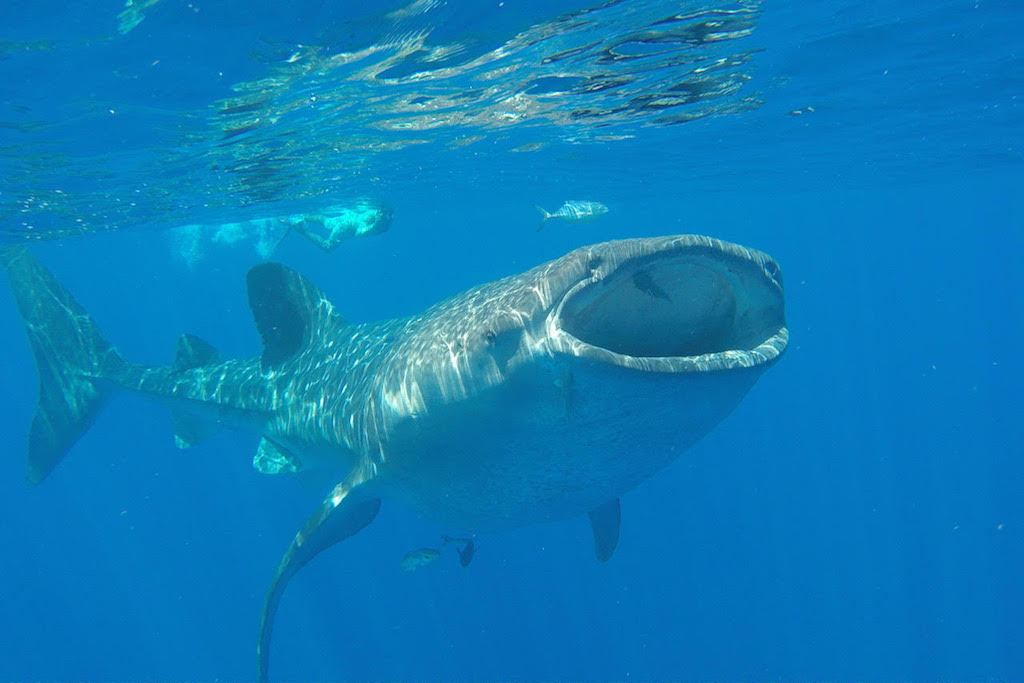
Utopia Village is dedicated to sustainable whale shark experiences by refusing to allow any feeding, touching or diving. At first I wrestled between my desire to interact more with the whale sharks and my deep belief that I should leave the ocean without a trace of having been there. Lead by the dive masters and owners of Utopia Village my selfishness gave way to the sustainable vegetarian in me and I celebrated the opportunity to interact peacefully with the whale sharks.
Once the captain spotted a whale shark we were instructed to slide off the boat as gently and quietly as possible, so as to not disturb or frighten them. Ultimately I was able to make several trips with Utopia Village where we spotted whale sharks, each experience more incredible than the last. I floated above or next to them quietly observing their natural way of life. All of the divers agreed that the sustainable approach was rewarding. We felt as though we had a hand in finding and preserving these amazing creatures habitat, and protecting their way of life.
First hand experience by Florine, a dive travel blogger at World Adventure Divers
The primary purpose of my scuba diving trip to Utila, Honduras, was to spot a whale shark. After many unlucky scuba diving trips, it was in the waters of the Bay Islands that I finally got the chance to swim with three whale sharks. As part of my daily scuba diving trips with Utila Dive Center, the captain of our boat was always scanning the horizon searching for the signs of their potential presence. The scuba diving instructors and divemasters on board briefed us with the highest standards when it came to swimming with whale sharks. We were taught how to interact without scaring them off or chasing them. “No splashing when entering into the water, no chasing, no touching!” and again and again “remember, no touching!!!”.

It was on my final scuba diving day that I finally saw whale sharks. The captain signaled that they were in sight and everyone rushed to get ready in their snorkeling gear. We were all waiting in line silently to get the “go ahead” from the captain to slide underwater as gently as possible. While in the water we could all observe the whale sharks for a few seconds without chasing them before they naturally swam away. After the whale sharks disappeared out of view we went back on board, slowly caught up to them again and repeated the operation seven times. Being a small group made the experience a lot easier to respect the natural habitat of the whale sharks.
Whale Sharks Maldives at Dhigurah Island
Ethical experience submitted by Nuraini Arsad from Teja on the Horizon
My experience swimming with whale sharks was on Dhigurah Island, as a volunteer for the Maldives Whale Shark Research Programme’s (MWSRP) data collection programme. When volunteering with MWSRP, you are trained on how to appropriately interact with the whale sharks in the Maldives. During my experience I was also able to learn important whale shark facts about their biology. I got a close-up look on how scientific research is carried out, which was the interaction I was looking for. Doing it this way means committing a solid two weeks, and fairly hard work – albeit in a gorgeous location.

Alternatively, for those looking for a less committed experience, there are many Maldives whale shark tours. Snorkeling with whale sharks in the Maldives offers many exciting opportunities for tourists around Dhigurah Island. The seas around Dhigurah are a congregation area for whale sharks and the probability of encountering a whale shark is quite high. Both the research boats and tour boats look for whale sharks using spotters on the top decks. Throughout the tour there is no attempt to influence the whale sharks’ natural behavior and the level of conservation awareness among tour operators in Dhigurah is fairly high. There are a set of whale shark tourism guidelines that the government of the Maldives has endorsed.
While researching whale shark tours in the Maldives you should look for tour operators and resorts who are members of the Big Fish Network, an online citizen-science platform for marine megafauna in the Maldives. The Big Fish Network means that information about the whale sharks and other megafauna you encounter on your holiday would be logged into the central database – and you could be part of that! And with the mobile app you can keep track of those same Maldives whale sharks you met on your trip, keeping Maldivian memories alive long after the holiday.
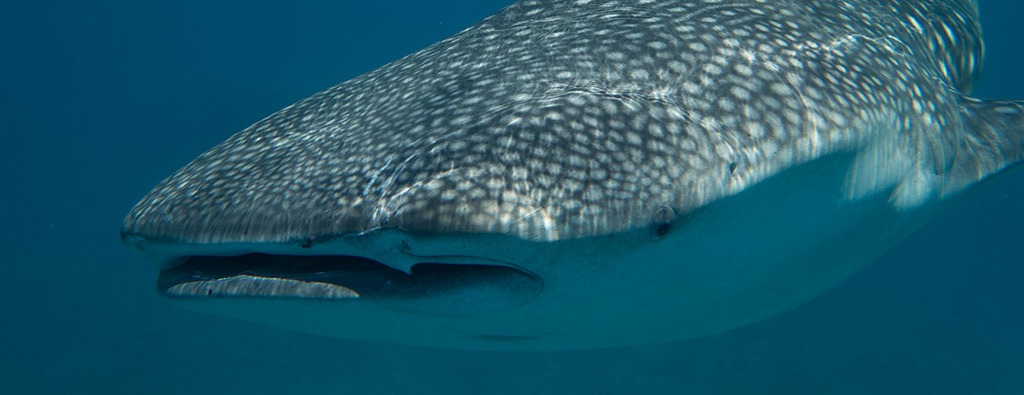
Whale Sharks in Djibouti
Submitted by Jeremy Gorelick who participated in a Dolphin Excursions Djibouti tour
In October of 2014, I was lucky enough to have a free day as part of an overseas business trip to Djibouti. I reviewed the different options for tour operators and, based on what I saw, I chose the one that was least impactful on the whale sharks in their natural habitat. Rather than chase the whale sharks the tour waited for them to come in closer to the spot where the boat stopped.
I am a patient traveler, who enjoys seeing animals in their natural habitat. I enjoy spending time observing them, rather than feeling like I need to “check an animal off of a list.” I had a far better experience with a more sensible and sensitive operator than others with whom I swapped stories that night, and recommend that anyone trying to see the whale sharks in Djibouti budget sufficient time. It is already a distance to get to them out on the water, so allocating a little longer while waiting for them to approach your vicinity is time well-spent.

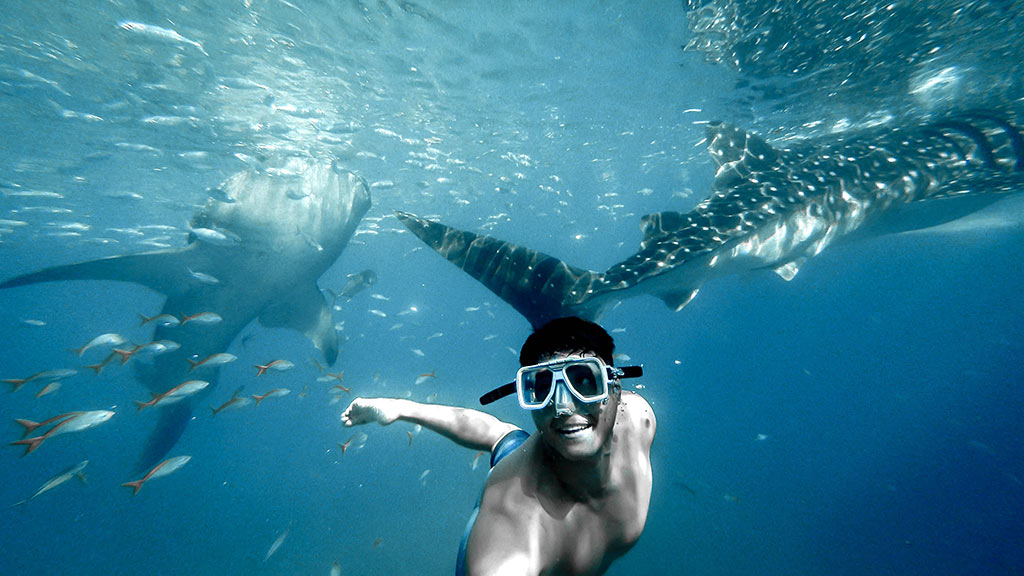


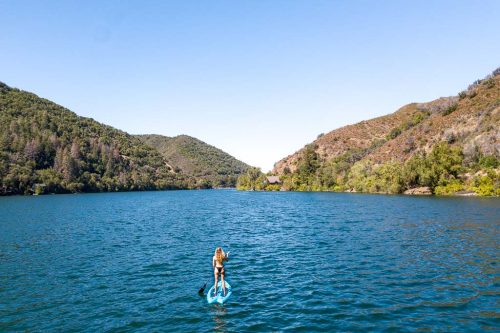



That is so awesome! Bet the experience is amazing. I’d freak out the first time.